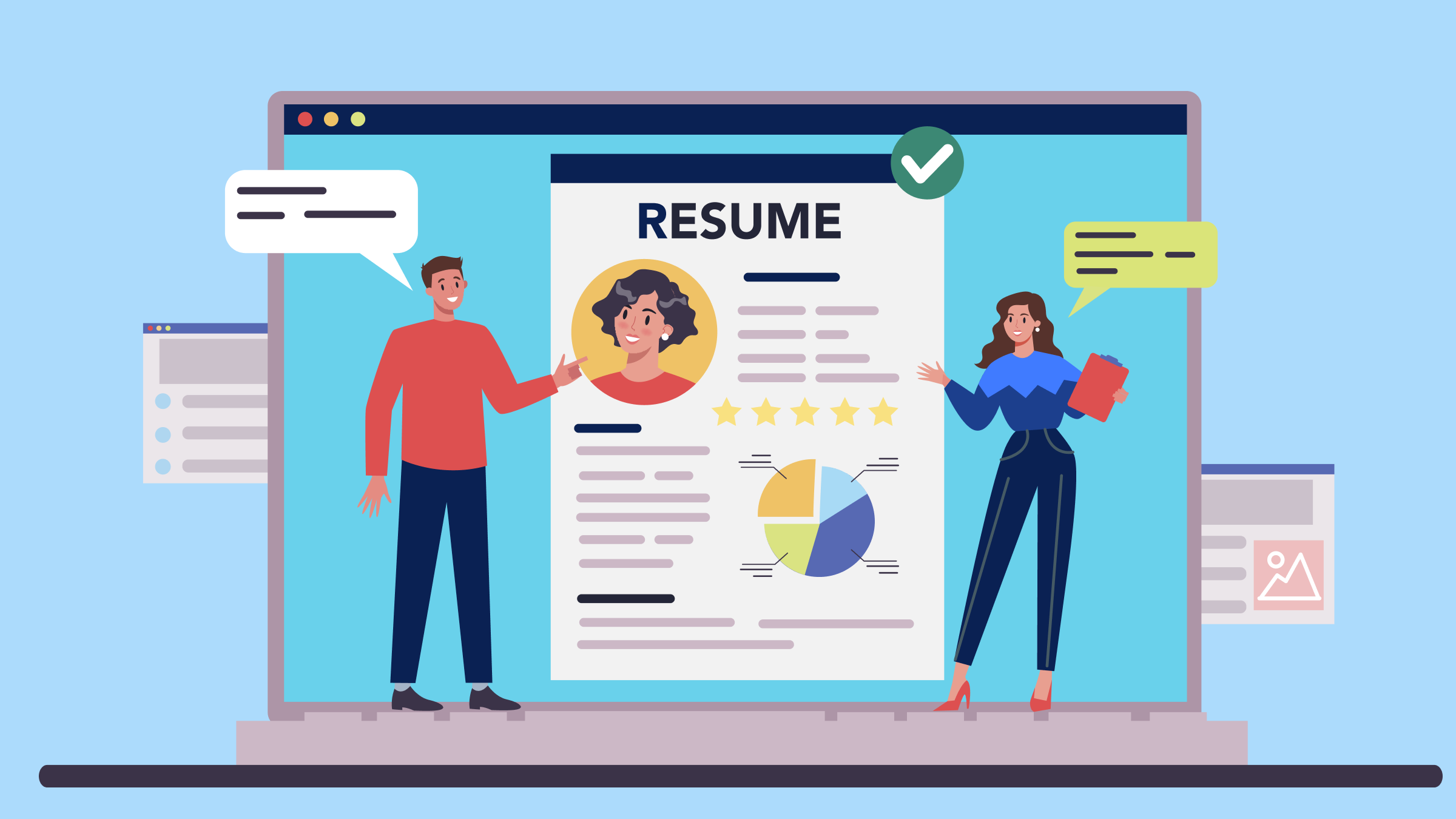Let’s get real about your internship resume — creating one that gets your foot in the door isn’t easy, especially if you have close to zero experience.
The good thing is, there are simple strategies you can use to maximize your chances. Firstly, never blast out one generic resume to every company on your list. Every single resume you send should scream, “I’m the perfect fit for this internship.”
Secondly, even if you’re low on work experience, find a way for your resume to highlight your strengths and key skills (we’ll cover that, and more, in depth).
Spend the next 7 minutes or so reading this guide, and this is what you’ll get:
- Five internship resume templates to use as inspiration
- How to write a resume if you don’t have experience
- A list of common mistakes to avoid
If you’re only looking for internship resume examples, here are five you can copy, adjust, and make your own:
Internship Resume Examples
Marketing Internship Resume Example
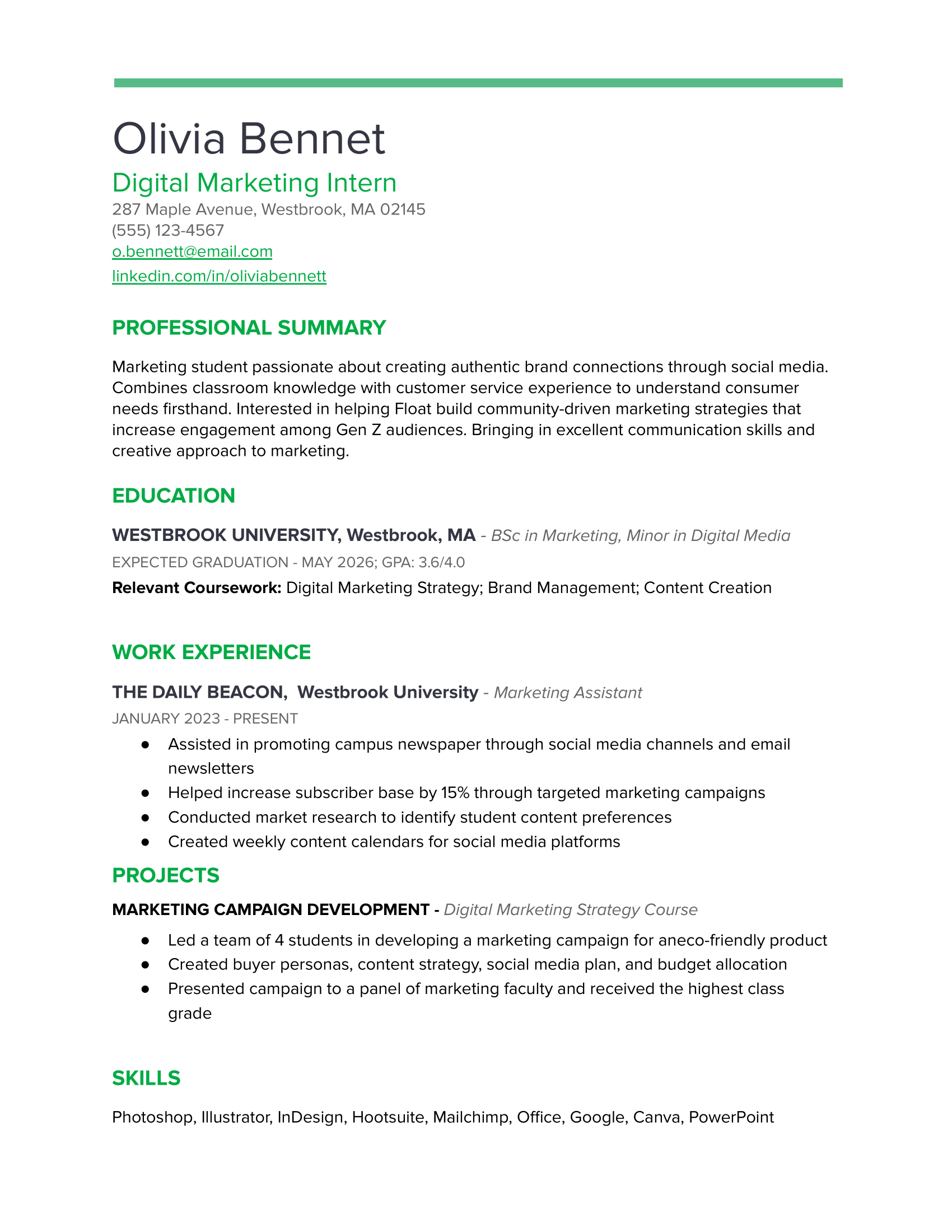
Engineering Internship Resume Example
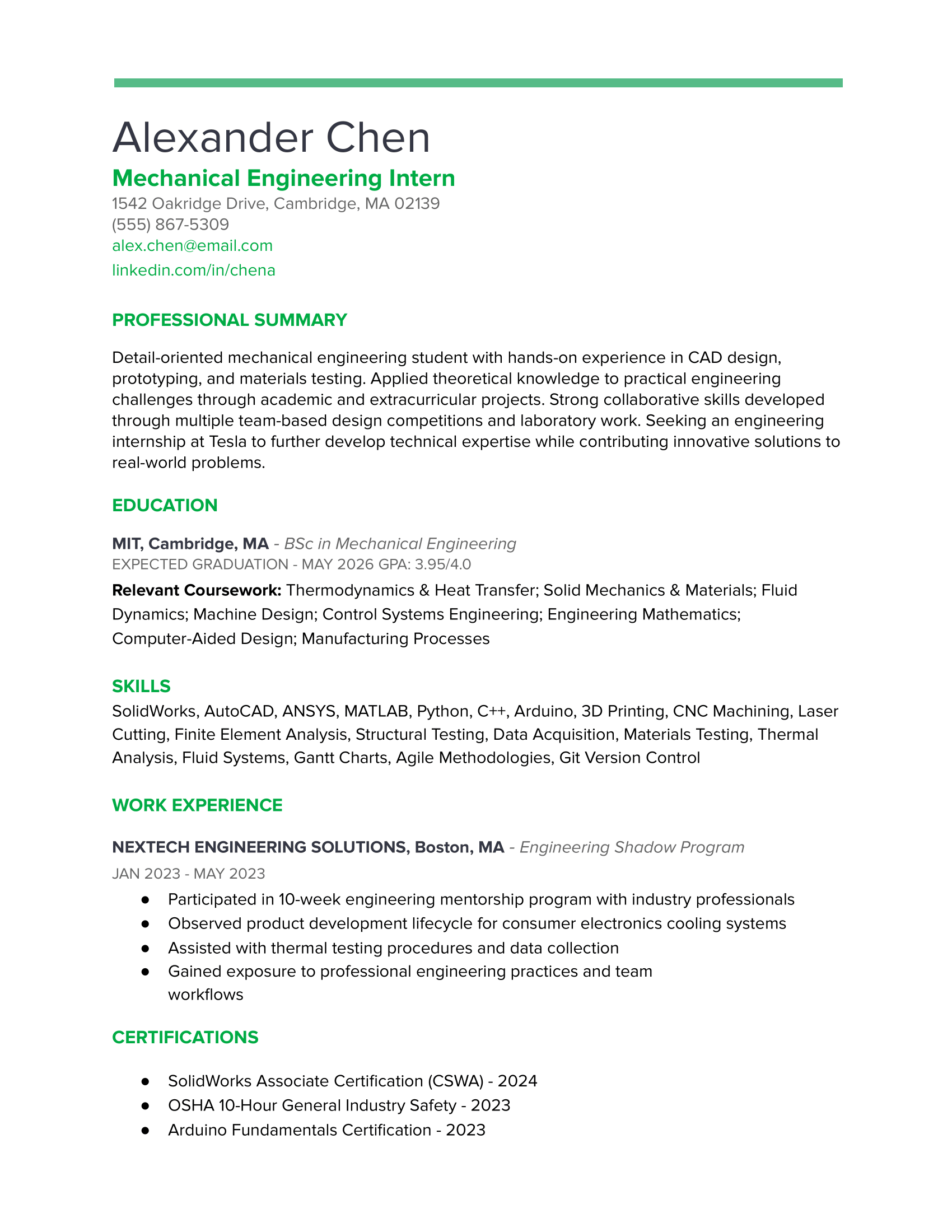
Accounting Internship Resume Example
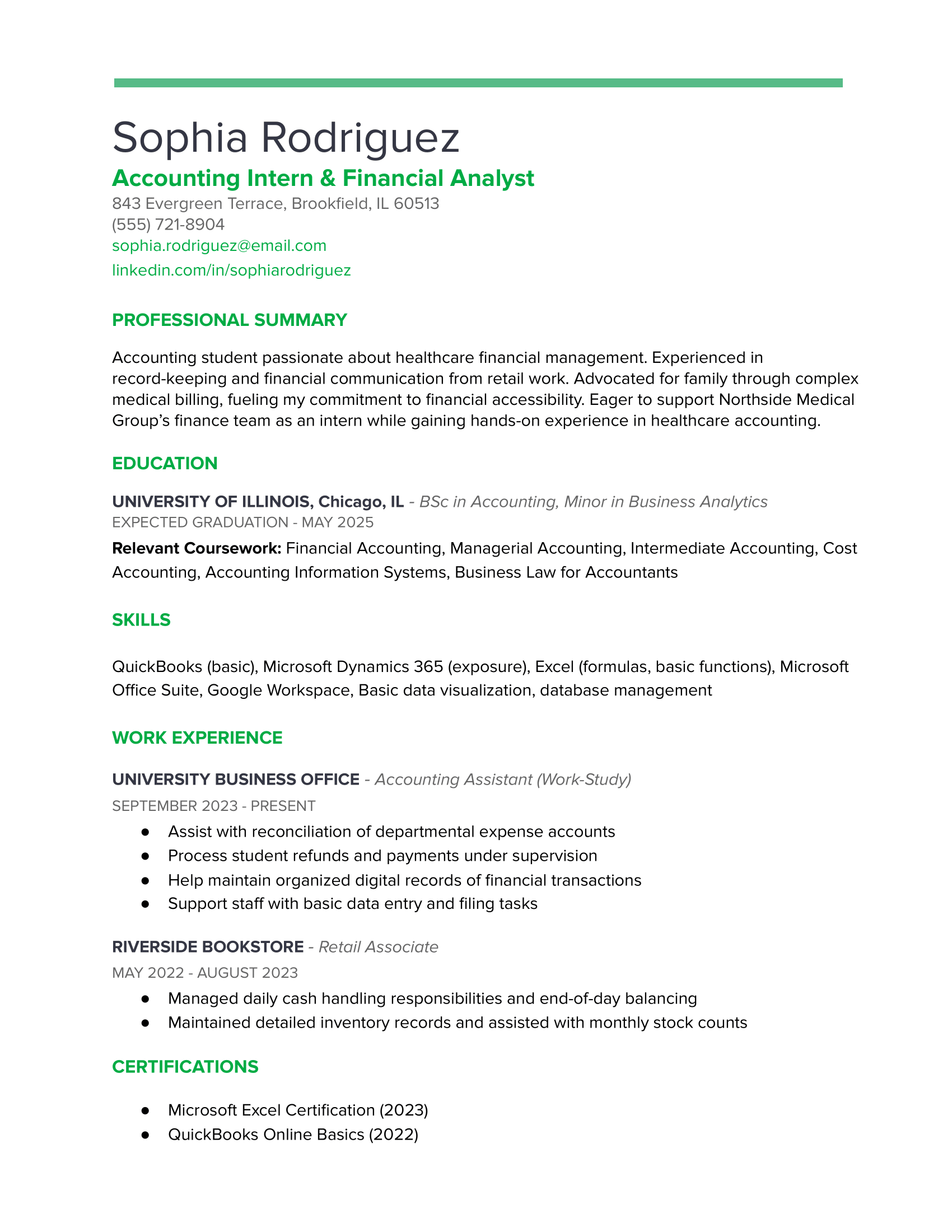
Financial Internship Resume Example
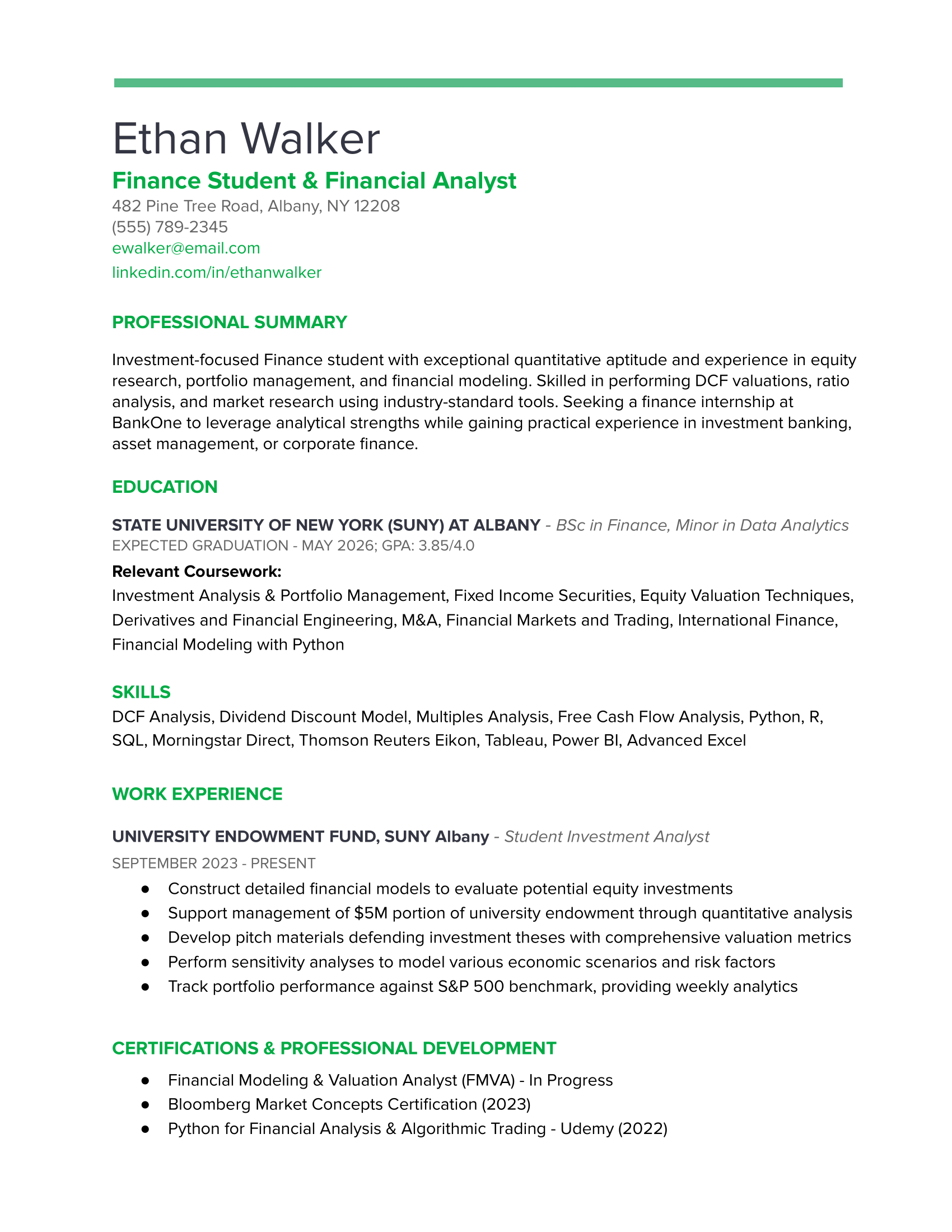
IT Internship Resume Example
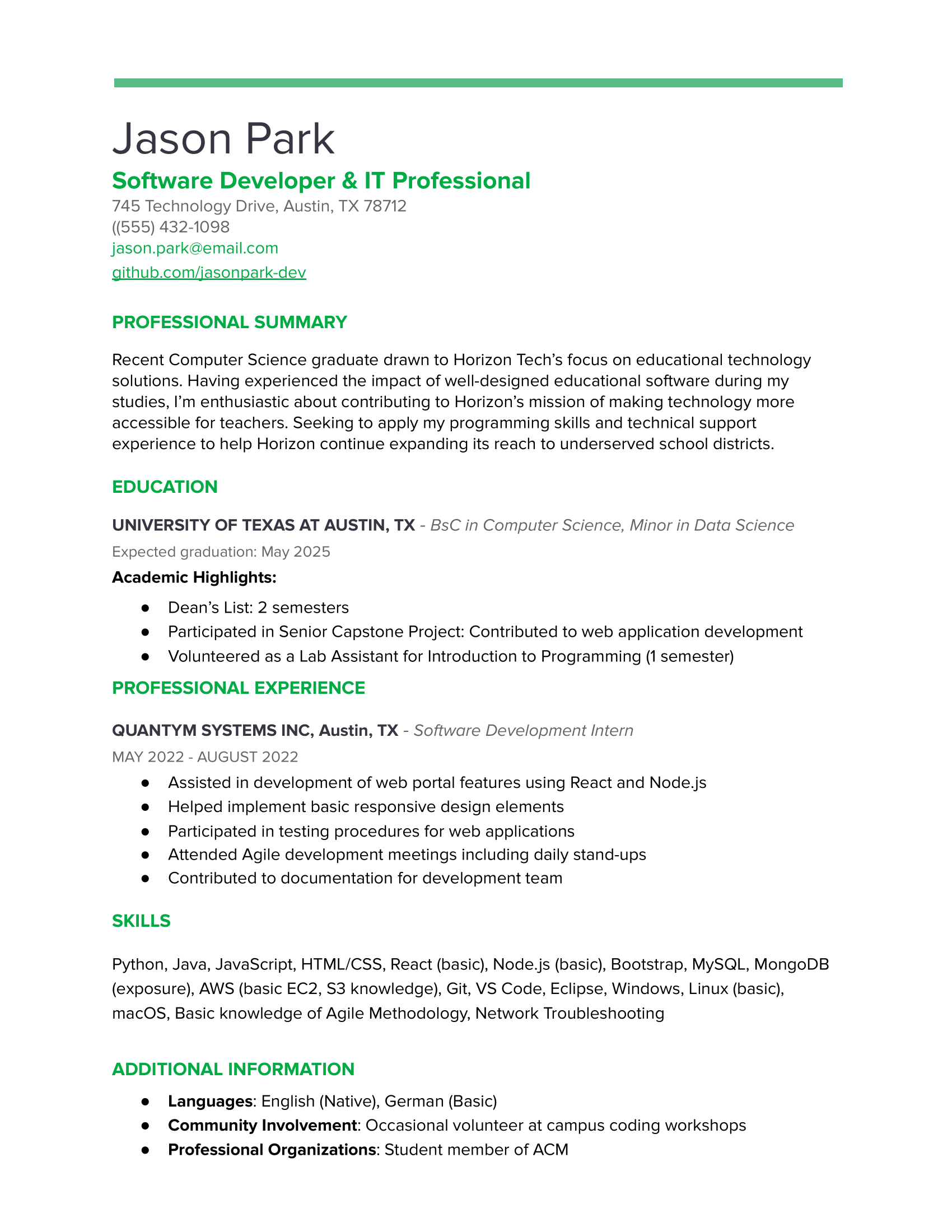
What to Include on an Internship Resume
For internship seekers, especially those new to the job market, your resume is the first contact with the employer and often determines if you’ll move forward in the application process.
Every resume for an internship needs to contain the following sections:
- Contact information: your full name, phone number, email, LinkedIn profile. Leave out personal details like age, exact address or personal social accounts. Don’t include a photo.
- Education: the place to highlight academic achievements, relevant courses, GPA (if higher than 3.5), and any honors or awards.
- Work experience: (if you have any, of course) including any paid or unpaid work (in any field), volunteer, or project experience with a focus on responsibilities and achievements.
- Skills: relevant skills, both technical and soft skills, that match the internship requirements.
- Additional sections: you can add a resume objective or a summary, certifications, foreign languages, extracurricular activities, and any other relevant experiences or achievements.
Now, let’s break down each step of internship resume writing (including the crucial preparation part).
How to Write a Resume for an Internship
Research, Prepare, and Customize
Sending the same generic resume to every internship doesn’t work and won’t get you far. Each company has its own culture, values, and requirements, and your resume should match that.
First, you want to take a good look at the internship posting. Most of the information you want to include in your resume will be spelled out. Here’s how to analyze it:
- Highlight the skills they mention more than once — If they talk about “data analysis” three times in the posting, guess what should definitely be on your resume?
- Look for specific software or tools — If they mention Excel, Canva, or Python, those need to be front and center in your skills section (if you actually know how to use them).
- Pay attention to the soft skills too — When they say “team player” or “self-starter,” those aren’t just fillers. Weave these qualities into your experience bullets. No need to go word-for-word here, but make sure your bullets display the soft skills they’re after.
- Split their requirements into “must-haves” and “nice-to-haves” — Focus on proving the must-haves, then add the nice-to-haves where you can.
- Use their language — If they call it “customer service” not “client relations,” use their terminology. Many companies use ATS (Applicant Tracking Systems) that scan for exact keyword matches, so matching their lingo is crucial.
Next, you want to tailor your intern resume to match the company:
- Check their social media — Are they formal and corporate on LinkedIn? Or are they one of those companies with a funny TikTok? This will tell you if your resume should be strictly business or if you can add a bit more personality.
- Check out their website beyond the careers page — Look at their “About” page, team photos, and company values. If they value innovation, you want to highlight your creative thinking. If they emphasize teamwork, make sure you stress your group projects.
- Get in touch with current or former interns — See what they’re highlighting in their LinkedIn profiles. This will give you insider info on what the company actually values, not just what they say they value.
- Reach out to people who work there — A quick “I’m really interested in your internship program and wondering what qualities make interns successful there” message can give you gold-tier insights. The worst they can do is ignore you, and the best? You might make a connection that remembers you when applications come in.
💡Pro tip: Take the job description and literally place it side-by-side with your resume draft. For each requirement they list, make sure you have something that addresses it. For example, if they want “experience with data visualization” and you once created charts for a class project, that’s your in. Just describe it using similar terminology: “Created compelling data visualizations to present research findings to a 30-person audience.” If you are a ResumeAI user, you can check this by going to the ATS tab of your resume review and looking at the “Keywords Not Matched” section.
Use the Right Structure and Format
Your resume could have all the right ingredients but still flop if it’s structured chaotically. There are three typical resume structures everyone uses:
- Chronological format — The classic and best choice for 95% of candidates at your level. Lists your education, then your work experience from most recent to oldest.
- Functional format — Organized by skills rather than timeline, and rarely works for internship resumes unless you are looking for a creative internship where your portfolio matters more than your credentials.
- Combination format — Takes elements from both approaches, but it’s difficult to write when you’re just starting out.
Bottom line — If you are a new grad or current student, it’s best to use the chronological format with a minor modification — put your education above your work experience.
Learn more about this in our dedicated article on resume formats.
Ensure a Professional Layout
✔️DO:
- Use consistent formatting for each section (same font, size, and spacing)
- Create clear visual hierarchy with headers and sub-headers
- Leave plenty of white space for the document to “breathe” and be more readable
- Use bullets for easy scanning
- Save as a PDF to preserve your formatting (unless specifically asked for another format)
✖️DON’T:
- Go over one page for internship resumes — edit ruthlessly
- Use more than two fonts or get wild with colors (even if applying for creative roles)
- Include photos of yourself (standard in the US, though practices vary internationally)
- Forget to rename your file to something professional (FirstName_LastName_Resume.pdf)
- Trust your computer’s spellcheck completely, make sure to get human eyes on it
💡Pro tip: Your resume should be mobile device friendly. Open it on your own phone before sending it. If you have to zoom and scroll horizontally, you want to simplify and shorten.
INSTAGRAM POST 1
Write Each Section of Your Internship Resume
Let’s break down what goes where and how to make each section work in your favor.
Objective or summary statement
A summary should be a quick snapshot, not a full paragraph. You want to highlight your strengths by mentioning your field of study, main skills, and relevant coursework or experience. Read the job description and include keywords that match what the company is looking for. Finally, explain what you want to gain from the internship and how it aligns with your career path.
Strong examples:
- Marketing — “Creative communications student with hands-on experience growing engagement by 30% through social media campaigns. Passionate about leveraging data and visual storytelling to drive brand impact. Excited to support GroupM’s mission of reshaping media through innovation, using my Canva expertise and analytical mindset to contribute to digital marketing strategies.”
- Engineering — “Mechanical engineering junior with robotics project experience, including leading a team to build a line-following bot that placed top 10 in a regional competition. Eager to contribute CAD design, prototyping, and problem-solving skills at TechFuture Industries, especially in their work advancing sustainable automation solutions.”
- Accounting — “Motivated finance student with QuickBooks certification and experience preparing monthly financial statements for a local nonprofit. Drawn to Morgan Financial’s commitment to transparent client reporting and eager to grow as an Accounting Intern while applying my skills in reconciliation, reporting, and accuracy-driven analysis in a real-world setting.”
Experience
The experience section helps to show your relevant skills, projects, and achievements, even if you don’t have traditional work experience.
Here are some rules to make your experience more professional and memorable:
- Mention all kinds of work experience, including unpaid or part-time jobs, even if outside of your desired field. At this stage of your career, any work you’ve ever done counts.
- Start each bullet with a power verb (created, increased, managed, led). These verbs convey action and make your experience sound more dynamic, impactful, and results-driven.
- Quantify your achievements by including numbers whenever possible (10% increase, managed $2,000 budget, supported 10+ clients)
- Connect your past to their future to show how your campus job taught you skills relevant to their internship.
- Don’t just talk about what you did, focus on how well you did it. Mention things like positive feedback from customers or supervisors, how frequently you completed certain tasks or (if applicable) how you contributed to the business goals.
Education
The education section is crucial for an internship resume because it provides context for your qualifications, especially if you have little work experience. It shows hiring managers your field of study, relevant coursework, academic achievements, and any specialized training that aligns with the internship.
- List your degree, university, and expected graduation date
- Include your GPA if it’s 3.5+ (or if specifically requested)
- Add 3-5 relevant courses that align with the internship requirements
- Highlight standout projects that demonstrate real-world applications of your coursework
- Mention academic honors or dean’s list if applicable
Skills
Every job experience comes with skills, even if it’s not directly related to the internship. Whether it’s communication from a retail job, problem-solving from tutoring, or time management from balancing work and school, every role teaches something useful.
Your skills section should be a quick-scan list of keywords that match the job posting.
- Break skills into categories (Technical, Software, Languages, Interpersonal)
- Be specific about technical skills (“Proficient in Python” rather than “Computer Skills”)
- Include proficiency levels for accurate representation (and be realistic)
- Incorporate exact phrases from the job description to ensure you pass a quick scan
- Only list skills you can actually demonstrate (because you might get tested).
Additional sections
The “extras” can set you apart, especially when your experience is limited.
- Certifications — Include industry-relevant certifications, even if they’re free online courses. This shows you have a learner mentality and that you took the time to take a relevant course that would set you apart from other candidates.
- Languages — List languages with proficiency levels (Conversational Spanish, Fluent Mandarin).
- Volunteer work — Especially if it demonstrates leadership or skills relevant to the internship.
- Campus involvement — Focus on roles and accomplishments, not just membership.
- Projects — Perfect for showing initiative and practical application of skills.
💡Pro tip: Recruiters initially scan resumes for under 30 seconds. If someone glanced at your resume for, say, 25 seconds, would they see your best stuff? That’s why you want to have proper formatting and put your most impressive qualifications where they’ll be seen first.
Tailor Your Resume for Each Application
If there is one thing to remember from this guide, it’s this one — generic resumes blend in and don’t land internships. Each time you apply, you’ll need to hand in a new, customized version of your general resume. If you do, you’ll be ahead of 90% of your peers.
This doesn’t have to be a nightmare — you can efficiently personalize without starting from scratch each time.
Here’s how to customize your resume for each opportunity in 5 simple steps:
Step 1 — Create a master resume with all your experiences. This will be your starting point, but you should select relevant items for each application.
Step 2 — Mirror the language from the job posting, so if they say “project management,” don’t call it “task coordination.”
Step 3 — Rearrange your bullet points to put the most relevant experiences at the top of each section.
Step 4 — Adjust your skills section to prioritize the exact skills mentioned in the posting.
Step 5 — If you decide to include the resume summary, update it to specifically name the company and position.
Your word choice can transform bland descriptions into impactful achievements. Use:
- Strong action verbs that show initiative — Instead of “Was responsible for social media” → “Managed 3 college social media accounts, increasing engagement by 24%.”
- Industry terminology — For a marketing internship, you could include phrases like “campaign analytics,” and “conversion rate”, as well as the names of the tools you can work with.
- Achievement-focused language that highlights results — Instead of “Helped with customer issues” → “Resolved average of 45 customer inquiries daily with 96% satisfaction rate.”
Run a Quick Self-Assessment
As a final check, go back to your resume and highlight every instance where you’ve specifically addressed a requirement from the internship posting. Any sections without highlights could use more tailoring.
Tailoring doesn’t mean fabricating experience but strategically presenting your authentic experiences in a way that connects directly to what the employer is looking for. You’re essentially translating your experience into their language to make it easier for them to see you as an ideal candidate for the internship.
If you’re a Big Interview user, you can create your internship resume in the Resume Builder. As you work on your resume, you can also add a job description and you’ll get tips on what skills and bullet points to include:
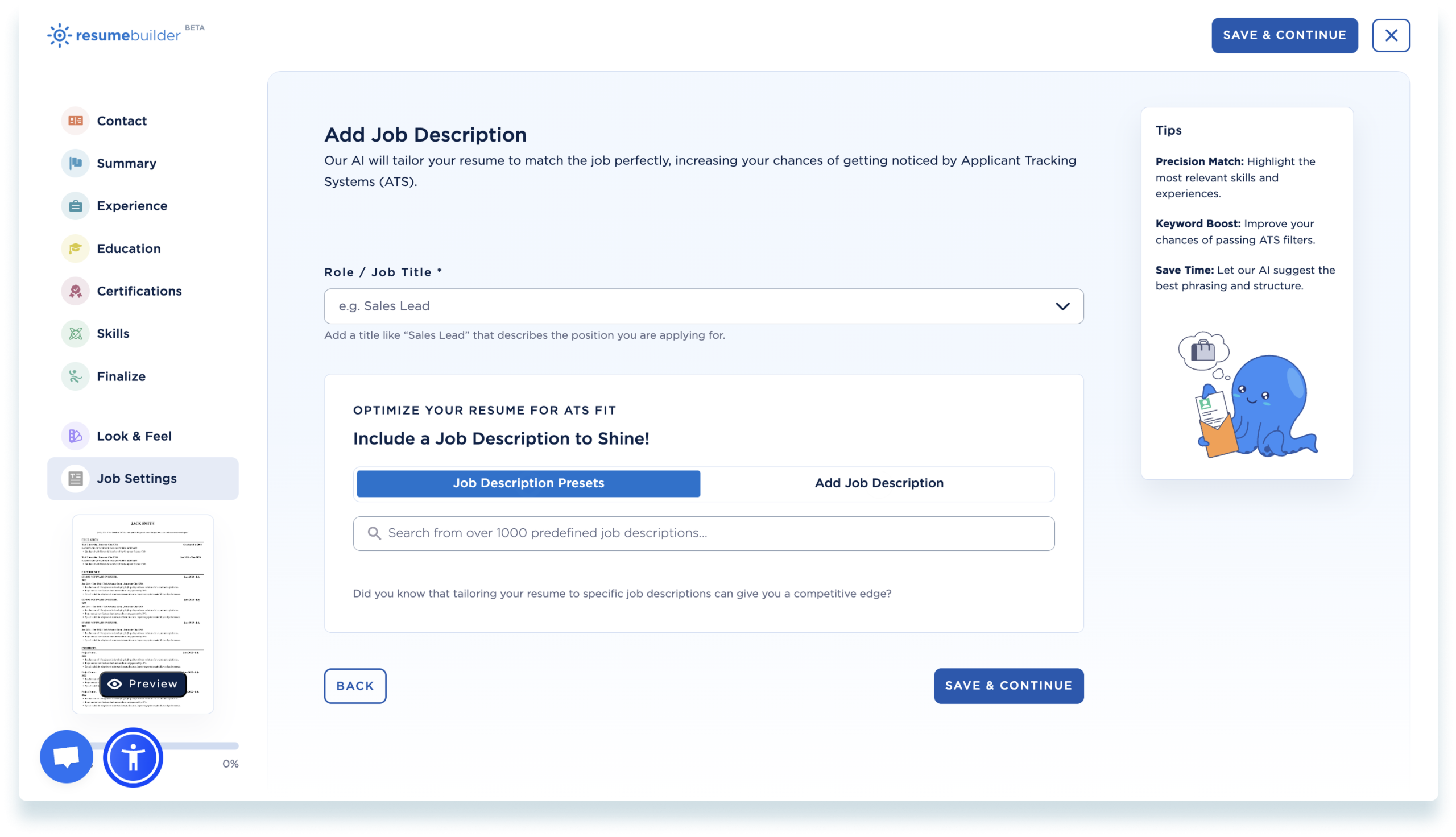
Common Internship Resume Mistakes to Avoid
Even the strongest candidates miss out on opportunities because of (totally avoidable!) resume mistakes, like vague summaries, poorly formatted sections, or missing relevant keywords. Here’s what to watch for — and how to fix them.
Too Much Information
Your resume isn’t your life story or a list of everything you’ve ever done.
- Skip the obvious stuff — We all know you can use Microsoft Word and email. Unless the job specifically asks for these skills, use that space for something more impressive.
- Ditch the high school achievements — Once you’re in college, your debate team victory from sophomore year of high school is no longer such a big deal (unless you have zero college experiences to list). That said, something *insanely* impressive from your pre-college days like, say, making the finals of Spelling Bee should stay on your resume.
- Cut the fluff — Phrases like “responsible for” and “duties included” take up space without adding value. Get to the point with action verbs instead.
INSTAGRAM POST 2
Copying, Pasting, and Spamming
Using the same resume for every internship won’t do you any favors. Employers want to see how your skills and experience align with their specific role. Taking the time to tailor your resume — even small adjustments — can make a big difference in getting noticed.
Also, using AI can be a big mistake — employers can tell when you’ve sent them a generic resume that wasn’t customized for their position. Each internship values different skills, so something that impresses a marketing agency might not matter to a marketing team in a software company.
Your objective statement is a dead giveaway. If it doesn’t mention their specific company or position, they’ll know you’re mass-applying.
Typos and Grammar Fails
Nothing says “I don’t pay attention to details” like spelling and grammar mistakes on the document that’s supposed to prove you pay attention to details.
- Spell check isn’t enough — It won’t catch if you wrote “their” instead of “there” or “manager” instead of “manger.”
- Read it out loud — Your ears will catch awkward phrasing your eyes might miss.
- Ask someone to proofread it for you — Your brain automatically corrects your own mistakes when you’ve been staring at the same document for hours.
- Triple-check contact info — Imagine losing your dream internship because you mistyped your own phone number or email.
If you’re doing your resume in Resume Builder, you can easily check this by going to ResumeAI and loading your resume. In just two or three minutes, you’ll get complete resume feedback, including a scan of typos and grammatical errors, with suggestions on how to improve them.
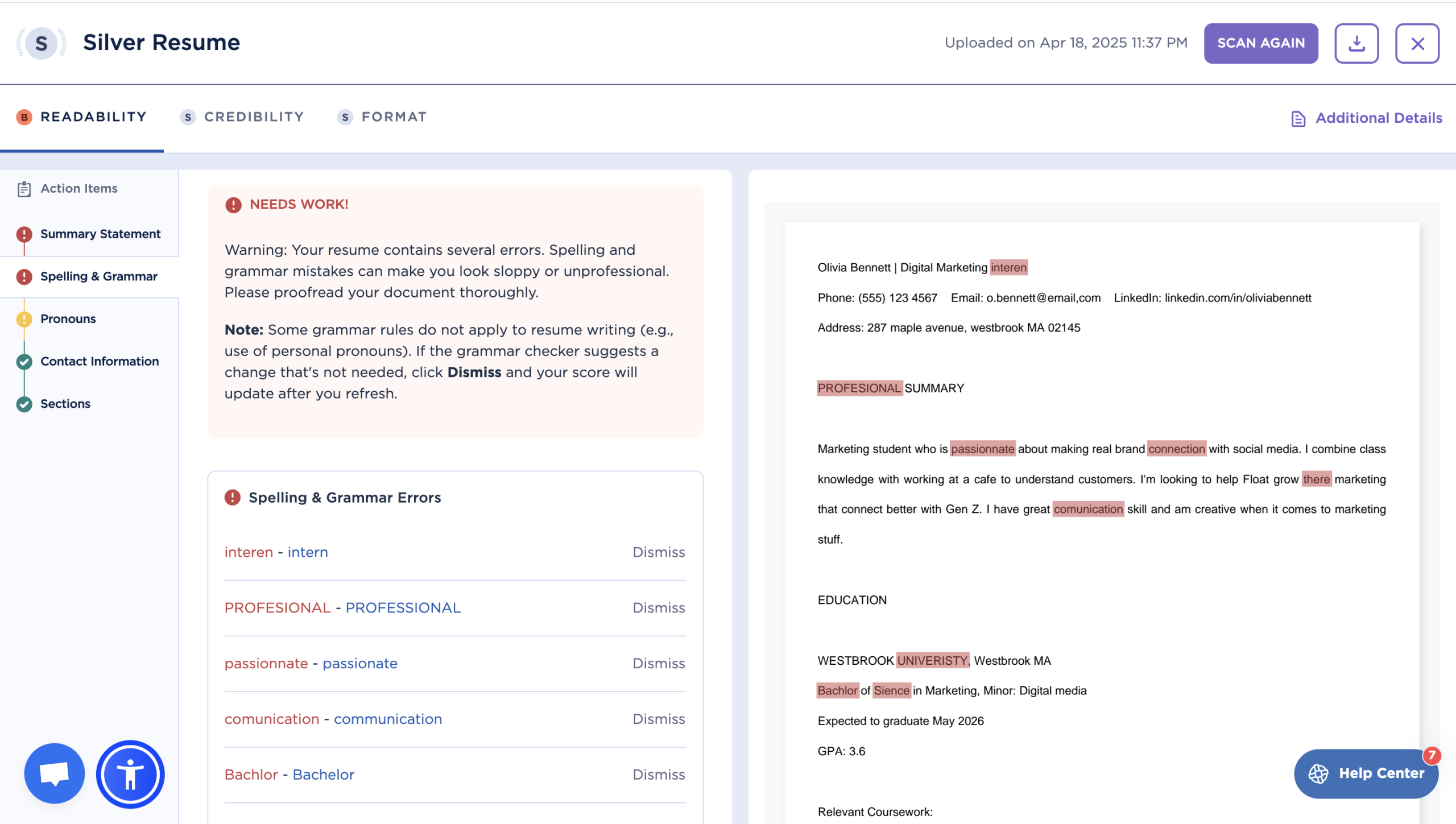
Irrelevant Information
Including experiences that have nothing to do with the internship might waste precious resume real estate.
Let’s say you worked as a camp counselor last summer and are now applying for a finance internship. You want to highlight relevant transferable skills like leadership and organization rather than dive into the day-to-day responsibilities of a camp counselor.
It’s a fine line, yes, especially if your experience is limited. Still, focus on showing how any past experience prepared you for your next career chapter.
Similarly, that random certification in something unrelated to the field doesn’t strengthen your application either.
Focus on the most recent things that really matter to the specific internship you’re applying for and the requirements they listed.
Summary of the Main Points
Here’s a quick overview of things to remember:
- An internship resume is a one-page document that summarizes your skills, education, and experience to help employers quickly assess your qualifications.
- Internship resumes should be one page long and contain the following sections: contact details, summary, education, experience, and skills. You can also include optional sections like certifications or memberships in relevant organizations.
- The education section is crucial for an internship resume because it provides context for your qualifications, especially if you have little work experience.
- The experience section may feel the most difficult to write because you may have little traditional work experience to put in it. Don’t take this quite literally — experience goes beyond paid jobs. You can include academic projects, any previous internships, volunteer work, leadership roles in student organizations, significant class assignments or research projects, and freelance or gig work.
- You can’t have one resume version and use it to apply to multiple internships. You need to customize your resume to each opportunity so that it reflects the requirements in the internship ad.
FAQ
Should I include my internships on a resume for a first full-time job?
Yes. Internships are one of the most relevant experiences you can include on a resume for your first full-time job. List them like job experiences — include the company name, your role, and key achievements. Highlight your impact by focusing on contributions and results rather than just duties. If you have multiple internships, prioritize those that are most aligned with the job you’re applying for.
What to do if my work experience so far is unrelated to my desired internship?
If your work experience is unrelated to your desired internship, focus on transferable skills and relevant coursework or projects. Even if your past jobs weren’t in your target field, they likely taught you useful skills like communication, problem-solving, or time management. Also, make sure to highlight any experience that involved “adult” stuff like cash and inventory handling or in-person customer service. If you took classes or completed projects related to the internship, you can create a “Relevant Experience” or “Academic Projects” section.
What’s the best way to find good internship opportunities?
There are many great ways to find internships. You can try platforms like LinkedIn, Handshake, Internships.com, Glassdoor or Indeed. Your university career center will often have exclusive listings. You can also attend career fairs or check company websites directly. Startups are interesting to intern at because they typically have less competition and tend to offer more hands-on work.
Do I need a cover letter for an internship?
Even if it’s listed as “optional,” a cover letter will give you a chance to show why you’re excited about the position. It will also let you highlight the skills your resume doesn’t fully capture. It’s your opportunity to stand out from other applicants and it’s definitely worth the effort.
Are remote internships worth it?
With remote internships, you’ll still develop key skills like digital communication, time management, and independence. If the internship provides real projects, mentorship, and skill-building opportunities, it’s definitely worth it. Just make sure the company is legit, offers structured work, and gives you regular check-ins with your manager and team members.
How do I list my education on an internship resume if I’m still studying?
If you’re still studying, list your education section at the top of your resume with your expected graduation date. Include your degree, university name, major, relevant coursework, and GPA (if it’s 3.5+). Even if you haven’t graduated yet, your current education is valuable to employers and shows you’re actively building relevant knowledge for the internship.
